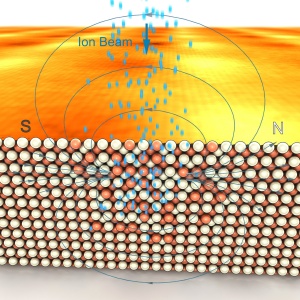Jan 29 2009
In order to achieve higher storage densities on computer disks, the last decades were dominated by optimization of magnetic materials, i.e. the magnetic particles (grains) were gradually shrunk while, at the same time, the magnetic stability (magnetic anisotropy) was increased. Usually, about 100 to 600 grains form one bit, i.e. the nowadays smallest storage unit.
 An originally ordered binary alloy (white and red atoms) is disordered by means of focused ion irradiation (visualized as blue spheres in the 3D sketch). The disordered phase is magnetic and hence produces a magnetic field with north and south pole, similar to a bar magnet. The arrangement of north and south pole is used to store the information.
An originally ordered binary alloy (white and red atoms) is disordered by means of focused ion irradiation (visualized as blue spheres in the 3D sketch). The disordered phase is magnetic and hence produces a magnetic field with north and south pole, similar to a bar magnet. The arrangement of north and south pole is used to store the information.
Each grain is about 10 nanometers in size. These grains are arranged next to each other on glass substrates that are plated with cobalt, chrome, and platinum. Both the size and amount of the grains necessary for one bit could not be decreased further without decreasing the signal/noise ratio. Weaker signals could even be accompanied by loss of information. Therefore, new concepts of magnetic storage have to be found.
Physicists from the research centre Forschungszentrum Dresden-Rossendorf / FZD (Germany), the Universidad Autonoma de Barcelona (Spain) and further research institutions were able to generate magnetic areas which promise to overcome the obstacles of today’s data storage technology. Using a highly focused ion beam, i.e. fast charged atoms, they irradiated an iron-aluminum alloy in such a way that only the treated zones became ferromagnetic. As the ion beam is focused to a size of only a few nanometers and the ion dose is rather low, the created nanozones are extremely flat and significantly less than 100 nanometers in diameter.
The read/write heads of personal computer disks fly above the hard disks at a distance of 20 nanometers. Conventional technologies for structuring material surfaces on the nanoscale result in corrugated surfaces. These technologies are not suitable for hard disks because the generated bumpy nanostructures would interfere with the read/write heads and might finally destroy the disk.
The new superflat nanomagnets, however, fulfill all requirements concerning a new concept for magnetic data storage. In the future, each of these nanomagnets could serve as one bit, provided that they could be produced in parallel on large areas via lithographic techniques, and shrunk in size down to about 30 nanometers. “We are now working on the magnetic stability of our nanomagnets. Its increase would be a further step with respect to future industrial exploitation”, says Dr. Jürgen Fassbender, scientist at FZD.